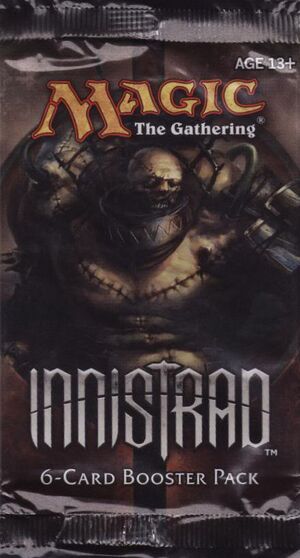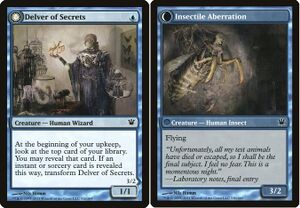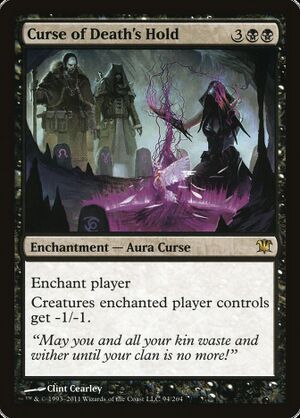Innistrad
- For other uses, see Innistrad (disambiguation).
| Innistrad | |||||
|---|---|---|---|---|---|
|
[[File:{{#setmainimage:ISD logo.jpg}}|250px]] | |||||
| Set Information | |||||
| Set symbol | |||||
| Symbol description | Two outward-facing, overlapping, stylized herons | ||||
| Design |
Mark Rosewater (lead), Richard Garfield, Jenna Helland, Graeme Hopkins, Tom LaPille | ||||
| Development |
Erik Lauer (lead), Mark Gottlieb, David Humpherys, Tom LaPille , Adam Lee, Kenneth Nagle | ||||
| Art direction | Jeremy Jarvis | ||||
| Release date | September 30, 2011 | ||||
| Plane | Innistrad | ||||
| Themes and mechanics |
Double-faced cards, Curse, "Graveyard matters", "Human matters" | ||||
| Keywords/ability words |
Flashback, Transform, Fight, Morbid | ||||
| Set size |
264 (15 basic lands, 107 commons, 67 uncommons, 59 rares, 16 mythic rares) | ||||
| Expansion code | ISD[2] | ||||
| Development codename | Shake | ||||
| Innistrad block | |||||
| |||||
| Magic: The Gathering Chronology | |||||
| |||||
Innistrad is the first set in the Innistrad block. It is the 56th Magic expansion and was released on September 30, 2011.
Set details
Innistrad is a top-down-designed Magic set, [3] [4] meaning that it was designed and developed with flavor in mind first, "molding mechanics to fit the concept". [5] The expansion symbol of the set is a depiction of two outward-facing, overlapping, stylized herons. [6]
Innistrad has a gothic horror theme and makes use of horror tropes. It is the first set to thematically take place on the plane of Innistrad. The set features graveyard [7] and tribal mechanics, with the five main tribes each being split over an allied color pair. [8] [9] Spirits primarily in white and blue, Zombies in blue and black, Vampires in black and red, Werewolves in red and green, and Humans primarily in green and white. In each of these pairs, the second color is considered the primary. There are also slight thematic differences between the tribes depending on the color, such as blue zombies being abominations of science in the vein of Frankenstein's Monster, while black Zombies are shambling corpses reanimated by magical spells.
Innistrad contains 264 cards (15 basic lands, 107 commons, 67 uncommons, 59 rares, 16 mythic rares), including randomly inserted premium versions of all cards in the set. [10] This is 15 more cards than any large expansion in recent history had. Innistrad also features a number of double-faced cards which have a card frame printed on each side, and a checklist card used to prevent decks from becoming marked by containing them. The checklist card replaces the basic land in three of every four boosters. Due to basic lands becoming more rare, Innistrad only contains three basic land artworks rather than the usual four, further enlarging the number of functionally different cards.[11]
Additionally, double-faced cards are on a different print run than regular cards, and every booster pack has a double-faced card. This means that boosters can have two (mythic) rares without either being foil. [12]
Innistrad featured the last Magic Invitational card: Snapcaster Mage, created by Tiago Chan. [13]
Flavor
| “ | Horror Lurks Within | ” |
Innistrad is a plane of menace and dread where every creature hides a darker aspect. Here, hedonistic vampires stalk the shadows to quench their thirst, and the full moon can transform a simple villager into a savage werewolf. [14] [15] [16] [17] [18] [19] [20] [21]
Marketing

Innistrad was sold in 16-card boosters, 6-card boosters, five intro packs, two event decks and a fat pack [22]. The 16-card boosters featured artwork from Liliana of the Veil, Garruk Relentless, Terror of Kruin Pass, Olivia Voldaren and Bloodgift Demon. [23] The small booster featured artwork from Grimgrin, Corpse-Born.
Innistrad was introduced by way of an Alternate Reality Game (ARG), in which bits of story were leaked in the form of various letters, journal entries and other in-world correspondences.[24][25] The prerelease of the set was September 24–25, 2011 [26], the launch party on September 30–October 3, 2011, the magic online release was October 17, 2011 and the Game Day was October 29-30, 2011. The promotional card given to participants at the Prerelease tournaments was the double faced Mayor of Avabruck / Howlpack Alpha. [27] The launch party promotional card was Ludevic's Test Subject / Ludevic's Abomination [28], and the Magic Game Day promotional card was a full-art Diregraf Ghoul (top-8 participants received a full-art foil Elite Inquisitor). [29] The Buy-a-Box card was Devil's Play. [27]
Regular boosters of Innistrad come with a bonus sixteenth card that is either a checklist card, a creature token or rules card with an advertisement on the reverse side.
Tokens
The Innistrad tokens in numerical order are: [30]
 4/4 Angel with flying produced by Geist of Saint Traft
4/4 Angel with flying produced by Geist of Saint Traft 1/1 Spirit with flying produced by Doomed Traveler, Geist-Honored Monk, Mausoleum Guard, Midnight Haunting, and Moorland Haunt
1/1 Spirit with flying produced by Doomed Traveler, Geist-Honored Monk, Mausoleum Guard, Midnight Haunting, and Moorland Haunt 2/2 Homunculus produced by Stitcher's Apprentice
2/2 Homunculus produced by Stitcher's Apprentice 5/5 Demon with flying produced by Skirsdag High Priest
5/5 Demon with flying produced by Skirsdag High Priest 2/2 Vampire with flying produced by Bloodline Keeper and Lord of Lineage, its back face
2/2 Vampire with flying produced by Bloodline Keeper and Lord of Lineage, its back face 1/1 Wolf with deathtouch produced by Garruk, the Veil-Cursed
1/1 Wolf with deathtouch produced by Garruk, the Veil-Cursed 2/2 Zombie (3 different images) produced by Undead Alchemist, Army of the Damned, Endless Ranks of the Dead, Moan of the Unhallowed, and Cellar Door
2/2 Zombie (3 different images) produced by Undead Alchemist, Army of the Damned, Endless Ranks of the Dead, Moan of the Unhallowed, and Cellar Door */* Ooze with "This creature's power and toughness are each equal to the number of slime counters on Gutter Grime." produced by Gutter Grime
*/* Ooze with "This creature's power and toughness are each equal to the number of slime counters on Gutter Grime." produced by Gutter Grime 1/2 Spider with reach produced by Spider Spawning
1/2 Spider with reach produced by Spider Spawning 2/2 Wolf produced by Garruk Relentless, Kessig Cagebreakers, and Howlpack Alpha
2/2 Wolf produced by Garruk Relentless, Kessig Cagebreakers, and Howlpack Alpha
Themes and mechanics

Innistrad is the first set to have cards with different card backs. These cards have two card faces on each side, and are used for the transformation mechanic, changing creatures into different creatures and back by turning the card over. [31] [32] When playing with double-faced cards, players may use a checklist which has a regular card back and the player marks on the card which double-faced card the checklist card is supposed to represent. Whenever the card is in a public zone, the checklist card is replaced with the double-faced card. Playing with only the double-faced card is also allowed if the player is playing with opaque sleeves. [33]


The transformation mechanic simply consists of the word "transform" written on the card in a sentence, similar to sacrifice, counter, or flip. The mechanic also introduces new symbols representing a sun and a moon which appear to the left of a card name similar to the tombstone icon marking graveyard-based mechanics in Odyssey block. The symbols specifically indicate the creature before transformation (day) or after transformation (night). Transforming creatures always enter the battlefield as they are before transformation, and once transformed not all creatures can transform back. During transformations, Auras, Equipment, and Counters stay on the creature.
Innistrad also introduces a new subtype for Enchantments named "Curse", which are simply Auras which enchant players and have a detrimental effect. The set is partially graveyard-based and features the return of flashback which originated in Odyssey and was reprinted during Time Spiral block. It also introduces the keyword action Fight, which represents the ability of Arena or Tahngarth, Talruum Hero. Two creatures that fight deal damage equal to their power to each other. Innistrad also features the new ability word Morbid in which creatures get benefits if another creature died the turn they entered the battlefield. [34] [35]
The set makes use of tribal mechanics, with Vampires, Zombies, Werewolves, Spirits and Humans giving bonuses to each other and have abilities that work against other tribes. A small theme of using +1/+1 counters is also used in the set, particularly with Vampires growing stronger by dealing damage.
Liliana Vess returned as a new card named Liliana of the Veil. Garruk Wildspeaker also returned on a new card, named Garruk Relentless. Garruk Relentless is a double-faced card and the first Planeswalker card with five loyalty abilities. It is also the first Planeswalker card with a continuous triggered ability and the first green-black Planeswalker. [36]
References to the number 13 are sprinkled throughout Innistrad cards.
Creature types
No novel creature types were introduced in this expansion.
Cycles
Innistrad has five cycles:
- Taplands: Lands that can produce either color of an Enemy-colored pair and come into play tapped unless the player controls a land with a basic land type of either color. This cycle completes a ten card cycle with the allied-colored taplands first introduced in Magic 2010 and reprinted multiple times in subsequent Core Sets. — Clifftop Retreat, Isolated Chapel, Woodland Cemetery, Hinterland Harbor, and Sulfur Falls. [37]
- Allied utility lands: A cycle of rare lands that tap for one colorless mana, or require an activation involving both colors of an allied pair to have an effect. — Gavony Township, Moorland Haunt, Nephalia Drownyard, Stensia Bloodhall, and Kessig Wolf Run. [38]
- Rare flashback cards: Each of these rare spells has a more expensive flashback cost. — Divine Reckoning, Cackling Counterpart, Sever the Bloodline, Devil's Play, and Creeping Renaissance.
- Allied flashback cards: Each of these common spells has a flashback cost involving the next color on the color wheel. — Feeling of Dread, Forbidden Alchemy, Bump in the Night, Ancient Grudge, and Travel Preparations.
- Enemy flashback cards: Each of these uncommon spells has a flashback cost involving the enemy color two slots earlier on the color wheel. — Rally the Peasants, Memory's Journey, Unburial Rites, Desperate Ravings, and Spider Spawning.
Vertical cycles
Innistrad has two vertical cycles:
- Stitcher Skaabs: Blue undercosted creatures that require creature cards to be exiled from the graveyard to be cast. — Stitched Drake, Makeshift Mauler, Skaab Goliath, Skaab Ruinator. Armored Skaab bears a similar name and is also a blue zombie, but does not share the same effect.
- Bloodsuckers: Red Vampires that become more powerful when they deal damage to an opponent. — Bloodcrazed Neonate, Rakish Heir, Falkenrath Marauders, Stromkirk Noble. Curse of Stalked Prey and Stromkirk Patrol also have similar abilities.
Reprinted cards
- Ancient Grudge, first printed in Time Spiral
- Blazing Torch, first printed as an uncommon in Zendikar, now a common
- Curiosity, first printed in Exodus, last seen in Eighth Edition
- Dissipate, first printed in Mirage
- Ghost Quarter, first printed in Dissension
- Mulch, first printed in Stronghold
- Naturalize, first printed in Onslaught, last seen in Magic 2012
- Shimmering Grotto, first printed in Lorwyn
- Think Twice, first printed in Time Spiral
Functional reprints
- Moon Heron, functional reprint of Snapping Drake (Portal) and Talas Air Ship (Portal Second Age), save for creature type
- Riot Devils, functional reprint of Minotaur Warrior (Portal), save for creature type
- Rotting Fensnake, functional reprint of Dross Crocodile (Fifth Dawn) and Skeletal Crocodile (Portal), save for creature type
- Thraben Purebloods, functional reprint of Siege Mastodon (Magic 2010), save for creature type
- Traveler's Amulet, functional reprint of Wanderer's Twig (Lorwyn)
- Voiceless Spirit, functional reprint of Pegasus Charger (Urza's Saga), save for creature type
Colorshifted
- Purify the Grave, white colorshifted version of Coffin Purge (Odyssey)
- Stony Silence, white colorshifted version of Null Rod (Weatherlight)
Card comparisons
Notable cards
- See also: Innistrad/Trivia.
- Delver of Secrets (along with its back face, Insectile Aberration), sometimes called a "blue Nacatl", is arguably the most effective cheap threat in its color (although it was not seen that way either in design or upon its release), widely played in aggro-control tempo decks across all constructed formats.
- Snapcaster Mage is the Magic Invitational prize card Tiago Chan made and finally collected after four years of development. It would be the last Invitational card released. Snapcaster Mage was a defining card in Standard, and has had a significant impact in Modern and Legacy as well for its ability to grant flashback to some of the most powerful cards in Magic's history.
- Geist of Saint Traft is a powerful early-game rush card, given that it's hexproof and can effectively deal 6 damage on turn 4. It is often used alongside Delver of Secrets for tempo.
- Olivia Voldaren is very reminiscent of Memnarch, being able to turn enemy creatures into vampires then gaining control of them just as Memnarch could turn creatures into artifacts and control them. Olivia, however, can only target creatures, but can power herself up this way in exchange for not being as permanent or flexible as Memnarch.
- Liliana of the Veil became one of the most powerful planeswalkers ever printed, second only to the infamous Jace, the Mind Sculptor. It is a Modern staple, especially in Jund and Grixis, and in BUG decks in Legacy.
- Intangible Virtue became part of a very powerful Tokens deck in Standard when combined with Lingering Souls from Dark Ascension. Both cards were later banned in Innistrad block constructed, and are part of the Modern BW Tokens deck, along with Morningtide's Bitterblossom.
- Diregraf Ghoul follows a long tradition of 2/2 Zombies for
 which includes Sarcomancy, Carnophage and Accursed Centaur. The first two cards saw widespread tournament play in Suicide Black decks.
which includes Sarcomancy, Carnophage and Accursed Centaur. The first two cards saw widespread tournament play in Suicide Black decks. - Laboratory Maniac is an alternate-win card.
Preconstructed decks
Intro decks
Innistrad has four bicolored theme decks.[39]
| Intro pack name | Colors Included | Foil rare | ||||
|---|---|---|---|---|---|---|
| Spectral Legions | W | U | Angel of Flight Alabaster | |||
| Eldritch Onslaught | U | R | Sturmgeist | |||
| Deathly Dominion | B | G | Skirsdag High Priest | |||
| Carnival of Blood | B | R | Falkenrath Marauders | |||
| Repel the Dark | W | G | Elder of Laurels | |||
Event decks
Innistrad has two Event decks.[40]
| Event deck name |
Colors Included | ||||
|---|---|---|---|---|---|
| Deathfed | U | B | G | ||
| Hold the Line | W | ||||
References
- ↑ Product info
- ↑ [1]
- ↑ Template:NewRef
- ↑ Template:NewRef
- ↑ Template:NewRef
- ↑ Template:NewRef
- ↑ Template:NewRef
- ↑ Template:NewRef
- ↑ Template:NewRef
- ↑ Template:NewRef
- ↑ Template:NewRef
- ↑ Template:NewRef
- ↑ Template:NewRef
- ↑ Template:NewRef
- ↑ Template:NewRef
- ↑ Template:NewRef
- ↑ Template:NewRef
- ↑ Template:NewRef
- ↑ Template:NewRef
- ↑ Template:NewRef
- ↑ Template:NewRef
- ↑ Template:NewRef
- ↑ Template:NewRef
- ↑ Template:NewRef
- ↑ Template:NewRef
- ↑ Template:NewRef
- ↑ a b Template:NewRef
- ↑ Template:NewRef
- ↑ Template:NewRef
- ↑ Template:NewRef
- ↑ Template:NewRef
- ↑ Template:NewRef
- ↑ Template:NewRef
- ↑ Template:NewRef
- ↑ Template:NewRef
- ↑ Template:NewRef
- ↑ Template:NewRef
- ↑ Template:NewRef
- ↑ Template:NewRef
- ↑ Template:NewRef